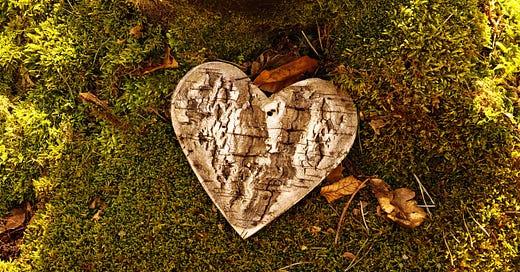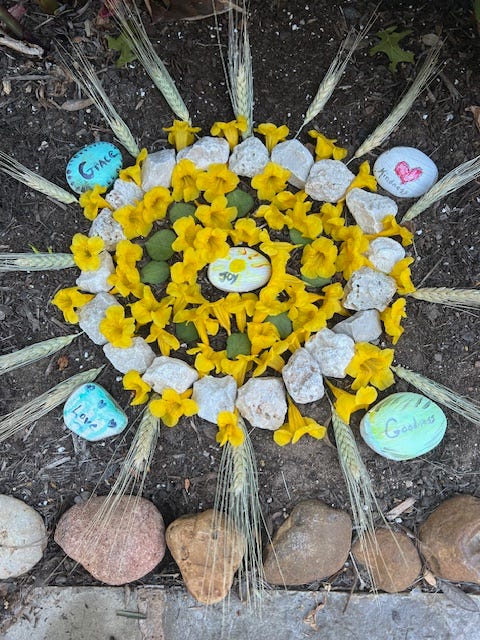Larkspur is a Conservation Burial Ground—an expanse of protected green space devoted to natural burial. With every burial, the land is rejuvenated, creating open green areas for the community to enjoy, while also fostering clean air and water. It is a profound legacy for future generations. (From the Larkspur Conservation Website)
Last night, John Christian Phifer visited my Morning Altars class to speak about green burial. John, a seasoned funeral director and embalmer, made the bold decision several years ago to depart from traditional funeral practices and founded Larkspur Conservation. Situated in Tennessee, in an area also known as Taylor Hollow, Larkspur offers an alternative vision for how we bid farewell to loved ones.
In our society, death is often sterilized and held at a distance, turning what should be an intimate and sacred passage into something we’re conditioned to avoid. Rather than perceiving death as a meaningful transition full of beauty, we have become reluctant to look too closely, robbing ourselves of the chance to participate deeply in the final act of laying our loved ones to rest.
Picture this: you stand amidst the splendor of nature, surrounded by the songs of birds and the gentle flutter of butterflies. A loved one has passed, and before you lies a recently dug grave, the bottom of which is adorned with flowers and petals. The body, wrapped in a simple white shroud or resting in a natural basket, is gently lowered by family members into this nest of earth and beauty. The family then shares in the sacred act of covering the grave with soil, finishing by scattering flower petals over the site. Through this ceremony, your loved one becomes part of the land, eternally present in the wildflowers and grasses of a welcoming meadow.
When my father died, he was embalmed and placed in a casket above a grave we never saw. It was as if he were locked in a box, and that was it. We chose not to have a minister officiate; instead, my siblings and I shared stories about our father with the guests. I know he would have embraced the idea of a green burial. His career with the Department of the Interior as a park naturalist and an analyst reflected his love and respect for the natural world. At the time, though, I hadn’t known anything about green burials.
My mother’s passing was more organic. She chose cremation, and we brought her ashes to the place where she grew up -- a prairie town where land and horizon stretch tight across the sky. The little town remains largely unchanged, surrounded by rolling hills, prairie, and endless sky, a comforting and timeless presence. We had permission from a local rancher to scatter her ashes in the hills above his land. I wrapped her ashes in a beautiful cloth and placed them in a special basket. My family shared stories at this natural grave site, and I read a poem I’d written for her. Together our family sprinkled her ashes and watched them swirl as they mingled with the rocks and pines. I felt a profound sense of peace. She was home.
On the way back, from what was a very intimate ceremony, we noticed a sign for the town’s cemetery. I turned the car, and soon we found ourselves standing by the graves of our great-grandparents—a reunion with our ancestors and the enduring landscape.
Funerals are a ritual—ashes to ashes, dust to dust—a sacred return to the earth from which we come, a connection to the divine embedded in the land. When John shared images of the graves he adorns, I found myself moved to tears. The rituals we craft, the beauty we create, grant meaning to the thresholds we cross throughout life and, ultimately, to the final threshold.
Rituals and ceremonies honor our lives and our connection to the natural world. They ease the pain and fear of the unknown, restoring a sense of balance with the Great Mystery. Through rituals, we can create beauty and meaning.
The Morning Altars teacher training speaks to a part of my soul that yearns to know the land intimately. In this, I see my father’s legacy within myself. By interacting with the natural world during important times, we recognize that we are not separate. We are in fact, nature itself. From this knowledge there is the potential to grow into more complete human beings. By respecting the earth and each other, and finding solace in the rituals that mark our thresholds, we can embrace the beauty of every step, right to the end.
bury me without a casket
wrap me in love and cloth
lay me gently in a grave of earth and flowers
where I can become nourishment
for green and growing things
may I be known
in meadows and forest trails
and in tears forged in the heart
of gentle memory
Thank you, as always, for reading my musings, for commenting, and most especially for being a kindred spirit who finds their way into meaning and goodwill. I may not know you face to face, but your light and your energy is no stranger to me and for this, I am grateful.







Such a beautiful and touching essay this week. I’d like a green burial but I’ve not the money for it. My momma has purchased a family plot and my ashes will likely be interred there alongside my father’s, who has gone on ahead, and my lil mom and brother when the time comes. I like the idea — and the picture you paint of the scattered ashes, and I’m not sure I want mine to be buried in the earth. Something I’ll need to work out. Thank you for food for thought.
This is such a beautiful idea. I would rather my remains go back to the Earth, either through ashes or a green burial, such as this.
Thank you for your wonderful articles .💜